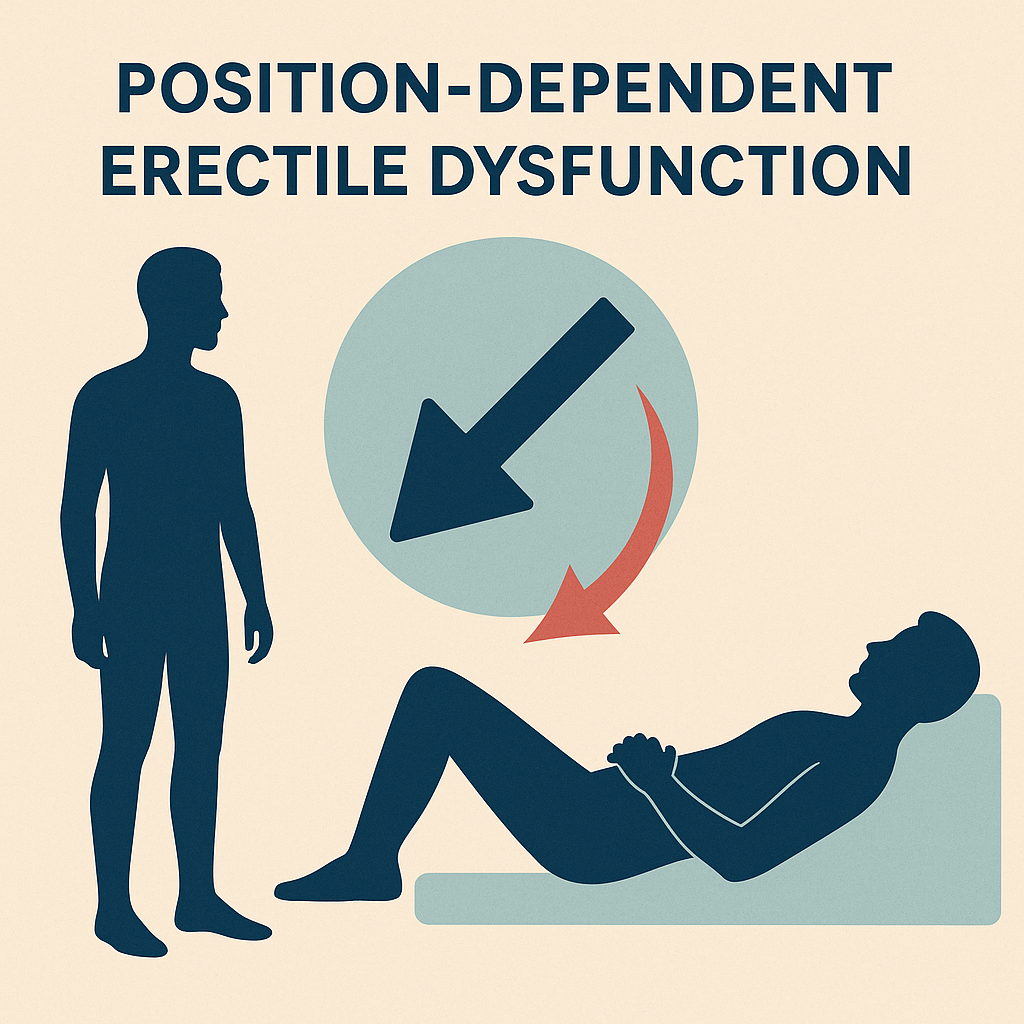Disclaimer
This article is for informational purposes only and not a substitute for professional medical advice. Always consult a qualified healthcare provider before starting any new treatment for erectile dysfunction.
Erectile dysfunction (ED) affects millions of men globally, but not all forms of ED are the same. Some men experience difficulties only in certain body positions — for example, while lying down but not standing, or vice versa. This condition is known as position-dependent erectile dysfunction (PD-ED).
If you notice that erections weaken or disappear when you change posture, you’re not alone. PD-ED is real, though often misunderstood. Understanding its causes and available solutions can help you regain control over your sexual function and confidence.
In this guide, we’ll explore what position-dependent ED is, why it happens, and most importantly, how to fix it through medical, physical, and lifestyle interventions.
What Is Position-Dependent Erectile Dysfunction?
Position-dependent erectile dysfunction refers to difficulty achieving or maintaining an erection based on the body’s position — such as lying on the back, side, or stomach, or sitting versus standing.
For instance:
- A man may have a strong erection while lying down but lose it when standing.
- Another may get an erection when standing but not when lying flat.
This pattern often indicates that something mechanical, vascular, or nerve-related changes with posture — rather than being solely psychological or hormonal.
Why Does Erectile Function Change With Body Position?
To understand why erectile function may change with position, it helps to know how an erection works. An erection occurs when blood flow to the penile tissues (corpora cavernosa) increases while venous outflow decreases. The process involves nerves, blood vessels, and muscles all working together.
When your body changes position, several physiological factors shift:
- Blood pressure and venous return: Posture affects how blood flows to and from the pelvis and penis.
- Pelvic muscle tension: Tight or imbalanced pelvic floor muscles can restrict blood flow or compress nerves.
- Nerve compression: Certain positions may pinch nerves involved in erection.
- Mechanical strain: Spinal alignment or hip rotation can alter how pelvic nerves and arteries function.
So, if your erections vary with posture, it’s a sign that one of these systems is influenced by position.
Common Causes of Position-Dependent Erectile Dysfunction
PD-ED can arise from a combination of vascular, neurological, musculoskeletal, and psychological factors. Let’s explore the most common causes:
1. Pelvic Floor Muscle Dysfunction
The pelvic floor muscles support the bladder, rectum, and penis. Weakness or tightness in these muscles can alter penile blood flow depending on posture.
- When lying down: Less muscle tension can mean better blood flow.
- When standing: Gravity increases pressure on pelvic veins, and weak muscles may allow premature blood outflow.
2. Venous Leak (Venogenic ED)
A venous leak occurs when blood flows into the penis but drains out too quickly. Posture changes can exacerbate this issue by altering venous pressure — for example, blood may escape faster when standing.
3. Pudendal Nerve Entrapment
The pudendal nerve carries signals that enable erections. If compressed by muscles, pelvic bones, or prolonged sitting, it can lead to numbness, pain, or loss of erection that worsens in certain positions (especially sitting).
4. Lumbar or Sacral Spine Problems
Nerves controlling erections emerge from the sacral spinal cord (S2–S4). Spinal misalignment, disc herniation, or lower back injuries can compress these nerves, making erections weaker in postures that strain the spine.
5. Vascular Insufficiency
If arteries supplying the penis are narrowed (due to atherosclerosis or trauma), blood flow may vary with posture. Some men find that lying flat improves blood flow, while standing reduces it due to gravity and vascular resistance.
6. Peyronie’s Disease or Penile Tissue Changes
Scar tissue or fibrotic changes in the penis can cause curvature and stiffness in specific angles, which can make erections unstable depending on position.
7. Psychological Components
Even though PD-ED is often physical, psychological anxiety can amplify it. If someone expects difficulty in a certain position, performance anxiety may make the problem worse.
Symptoms and Diagnosis
Recognizing PD-ED involves noticing consistent patterns:
- Erections only in specific postures (e.g., lying but not standing)
- Partial erections that weaken upon movement
- Associated pelvic discomfort, numbness, or pain
- Reduced rigidity or early loss of erection during sex in one position
- Normal morning erections (indicating intact nocturnal function)
Diagnostic Steps
A healthcare provider may recommend:
- Physical examination: Checking penile blood flow and nerve sensitivity.
- Penile Doppler ultrasound: Evaluates arterial inflow and venous leakage.
- Nerve conduction tests: Detect pudendal or spinal nerve compression.
- Pelvic MRI or CT: Identifies musculoskeletal or vascular causes.
- Nocturnal penile tumescence test: Confirms whether physiological erections occur during sleep.
How to Fix Position-Dependent Erectile Dysfunction
Treatment depends on identifying the underlying cause. The goal is to improve blood flow, nerve function, and muscle balance while addressing any psychological factors.
Let’s explore each approach in detail.
1. Pelvic Floor Rehabilitation
A key solution for PD-ED lies in pelvic floor therapy. Strengthening and relaxing these muscles improves blood flow and erection control.
a. Pelvic Floor Exercises (Kegels)
- How to do them: Contract the muscles used to stop urination, hold for 5 seconds, and release.
- Frequency: 10–15 repetitions, 3 times per day.
- Goal: Improve venous closure and rigidity.
b. Relaxation Training
If tight pelvic muscles are causing nerve compression, relaxation techniques such as diaphragmatic breathing, yoga, and stretches can help release tension.
c. Physical Therapy
A pelvic health physiotherapist can identify trigger points or misalignment contributing to dysfunction and provide guided rehabilitation.
2. Postural Correction and Spinal Care
If your ED worsens in certain postures, spinal alignment might be part of the issue.
a. Chiropractic or Osteopathic Treatment
Adjustments can relieve nerve compression around the lumbar and sacral areas.
b. Stretching and Strengthening Exercises
Target muscles that stabilize the pelvis — glutes, hamstrings, and core — to maintain balanced posture.
c. Avoid Prolonged Sitting
Use ergonomic chairs, take breaks every 30 minutes, and stretch hip flexors to reduce pudendal nerve pressure.
3. Medical Treatments
For men with vascular or mixed causes, medical therapy may be beneficial.
a. PDE5 Inhibitors
Medications like sildenafil (Viagra®), tadalafil (Cialis®), or vardenafil (Levitra®) improve blood flow to the penis.
They don’t cure PD-ED but can compensate for vascular irregularities.
b. Vacuum Erection Devices (VED)
A VED draws blood into the penis mechanically. It helps identify whether vascular inflow is the main issue.
c. Intracavernosal Injections
When oral medications fail, direct penile injections (e.g., Trimix) can achieve erections regardless of position — helping confirm if blood flow, not nerves, is the limiting factor.
4. Addressing Nerve Compression
When PD-ED is linked to pudendal nerve entrapment or spinal issues:
a. Nerve Decompression Therapy
Specialized physiotherapy, nerve gliding techniques, or targeted injections (like corticosteroids) may relieve compression.
b. Avoid Aggravating Positions
If sitting worsens symptoms, use cushions with cut-outs to reduce perineal pressure.
Cyclists should use seats with center cut-outs to prevent nerve compression.
c. Surgical Intervention
In rare cases, nerve release surgery may be required for chronic pudendal entrapment.
5. Vascular Treatments
If Doppler ultrasound reveals blood flow abnormalities:
a. Lifestyle Changes
Quit smoking, reduce alcohol, and maintain a healthy weight — all improve endothelial function.
b. Exercise
Aerobic activities (like brisk walking or swimming) enhance cardiovascular health and penile circulation.
c. Vascular Surgery
For severe cases, penile revascularization or venous ligation can improve arterial inflow or reduce venous leakage.
6. Psychological and Behavioral Therapy
Even when physical causes exist, psychological support enhances outcomes.
- Sex therapy: Helps reduce anxiety around certain positions.
- Cognitive Behavioral Therapy (CBT): Reframes fear or stress associated with sexual performance.
- Partner communication: Reduces tension and improves cooperation during treatment.
Home Remedies and Lifestyle Tips
While medical treatment is essential for lasting results, small daily changes can significantly improve function.
1. Optimize Blood Flow
- Maintain a balanced diet rich in omega-3s, antioxidants, and L-arginine.
- Avoid heavy meals and alcohol before sexual activity.
- Stay hydrated to support vascular performance.
2. Manage Stress and Sleep
Chronic stress increases cortisol, which can suppress testosterone.
Aim for 7–8 hours of sleep and include mindfulness or breathing exercises to maintain relaxation.
3. Stretch and Move Daily
Gentle yoga poses — such as happy baby, bridge pose, or pigeon stretch — improve pelvic flexibility and reduce nerve tension.
4. Track Your Patterns
Keep a journal noting:
- Which positions cause difficulty
- Any pain or numbness
- Time of day, stress level, or recent exercise
This helps your doctor pinpoint the root cause faster.
When to See a Doctor
Seek medical advice if:
- The problem persists for more than 3 months.
- There’s pain, numbness, or tingling in the groin or legs.
- Erections are only possible in very specific postures.
- There’s loss of morning or nocturnal erections.
- Over-the-counter treatments fail.
Ignoring PD-ED can allow reversible issues — like nerve compression or vascular weakness — to become chronic.
Future Outlook and Recovery
Most cases of position-dependent ED can be corrected or significantly improved once the cause is identified.
Recovery depends on factors like:
- Duration of symptoms
- Age and cardiovascular health
- Consistency with therapy or exercises
Men who combine medical treatment, physical therapy, and lifestyle correction often regain full erectile function within months.
Key Takeaways
- Position-dependent erectile dysfunction means erection issues vary by posture.
- Common causes include pelvic floor dysfunction, nerve entrapment, and vascular irregularities.
- Diagnosis involves physical exams, Doppler ultrasound, and nerve assessments.
- Treatment may involve pelvic exercises, medical therapy, spinal correction, or lifestyle changes.
- Early intervention greatly improves recovery chances.

